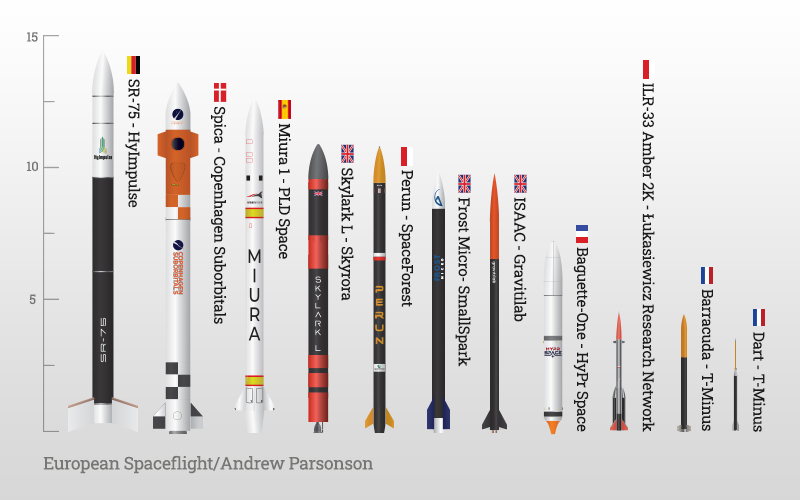
| Company | Country | Vehicle | Payload (kg) | Max Altitude (km) | Status |
|---|---|---|---|---|---|
| Copenhagen Suborbitals | Denmark | Spica | One Person | 105 | Development |
| Gravitilab | UK | MAX | 5 | Operational | |
| Gravitilab | UK | ISAAC | 20 | 250 | Development |
| Gravitilab | UK | FRANK | 50 | Development | |
| HyImpulse | Germany | SR75 | 350 | 150 | Testing |
| HyPr Space | France | Baguette-One | 300 | Development | |
| Łukasiewicz | Poland | ILR-33 Amber 2K | 20 | 100 | Testing |
| PLD Space | Spain | Miura 1 | 100 | 150 | Development |
| Skyrora | UK | Skyhy | 2 | Development | |
| Skyrora | UK | Skylark L | 50 | 102 | Testing |
| SpaceForest | Poland | Perun | 50 | 150 | Testing |
| T-Minus | Netherlands | Dart | 3.5 | 200 | Operational |
| T-Minus | Netherlands | Barracuda | 40 | Early development |
Despite not getting as much attention as their orbital-capable counterparts, there are several interesting European suborbital launch vehicles currently in development and operational use.
Some of these vehicles are being utilized as developmental stepping stones on the way to a larger vehicle. Examples of this kind of vehicle include the Miura 1 from PLD Space in Span, the SR75 from HyImpulse in Germany, and the Skylark L from Skyrora in the United Kingdom. Although these vehicles will serve at very least a brief operational life, the bulk of the work being done on these vehicles is in service of fine-tuning technology that will be utilized aboard larger vehicles. These vehicles will also allow these companies to begin generating income as they work towards orbital flight.
In addition to these developmental European suborbital launch vehicles, there are also several companies developing purpose-built suborbital vehicles. Examples of this type of vehicle include the T-Minus Dart and Barracuda from the Netherlands, the Perun from Space Forest in Poland, and the exciting-looking ILR-33 Amber 2K from Łukasiewicz in Poland. These vehicles are used for microgravity research offering a significantly more affordable entry point to those environments.
The final type of suborbital vehicle being developed in Europe is a crewed launch vehicle. This unique category is only being pursued by Copenhagen Suborbitals from Denmark with their Spica vehicle. The not-for-profit organization is developing the small launch vehicle with work from volunteers and funding from small donations and crowdfunding efforts. Once complete, the vehicle will be capable of carrying a single brave passenger in a small capsule to an altitude just above the Karman line, the agreed-upon boundary between Earth’s atmosphere and outer space that sits at an altitude of 100 km.


